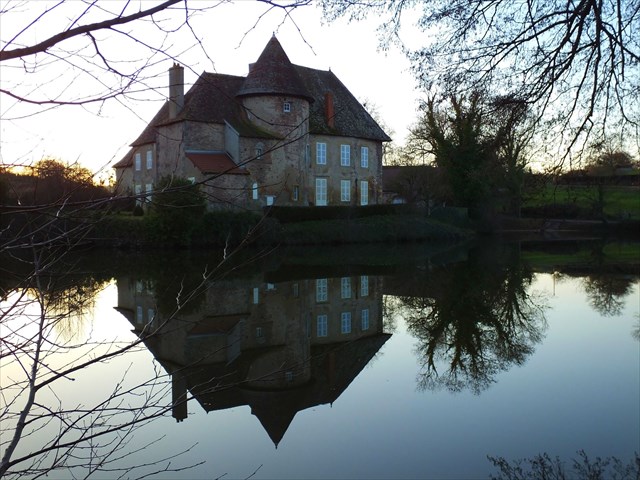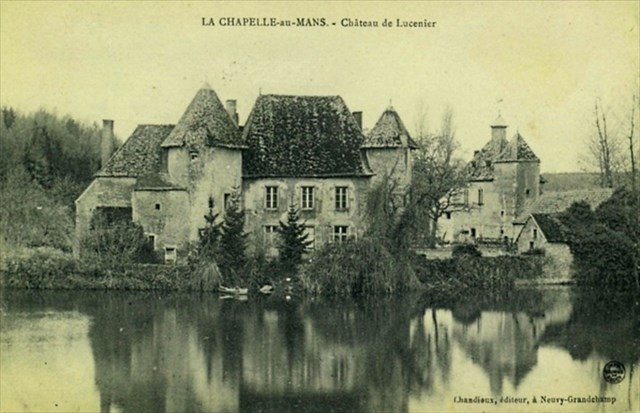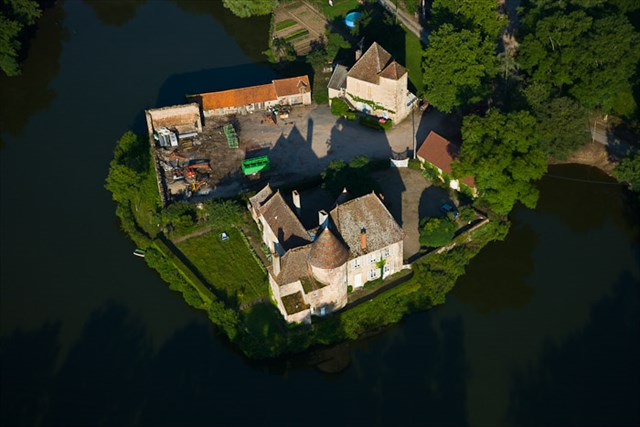Le Château de Lucenier
Lucenier est une maison forte, construite au cours du XIIIème siècle et faisant partie de la défense du Duc de Bourgogne.

À cette époque le Duc de Bourgogne demandait à ses vassaux de construire des châteaux forts ou des maisons fortes pour protéger les frontières de son Duché. C'est l'époque de la lutte pour le trône de France qui l'oppose au Duc d'Orléans. La Chapelle-au-Mans se trouvant alors à la frontière du Duché du Duc de Bourgogne et du Royaume de France.

Au Moyen Âge Lucenier était constitué d'un corps de logis flanque de trois tours rondes. Ce bâtiment et deux tours existent toujours. La disposition des bâtiments de la ferme jouxtant le château permet de se représenter l'emplacement des murs qui protégeaient la propriété.

Au XVIIIème siècle est construite une nouvelle aile pour relier l'ancien bâtiment à la chapelle.
Le chevalier Jehan de Montmorillon, un ancêtre du propriétaire actuel, acheta le fief de Lucenier en 1603 de Bertrand de Priezac. La famille De Montmorillon conserva cette propriété jusqu'à la Revolution. Après cette période, il y eut des propriétaires différents, parmi eux Jean-Baptiste Perrot, maître de forges à Gueugnon (1794 jusqu'au début du XIXème siècle).
La famille De Montmorillon racheta le château et une partie des terres en 1829. A ce jour, Lucenier reste une propriété privée qui ne peut être visitée.
Stationnement à proximité possible. Attention! Ne franchissez pas le propiété privée!
S'il vous plaît noter: Il s'agit d'un nano "spécial". L'aimant ne peut pas être retiré de l'objet. S'il vous plaît prenez uniquement le conteneur. Dans ce cas, s'il vous plaît assurez-vous que vous ne perdez pas le logbook. S'il vous plaît après avoir écrit sur le log, replacez le cache exactement sur l'aimant tel que vous l'avez trouvé. Il est plus facile de prendre le logbook avec une pince à épiler à partir du conteneur.
Lucenier is a so called „Fortified House“ built in the 13th century as part of the defense for the Duke of Burgundy.
At this era the Duke of Burgundy called his vasalls to built fortified castles or fortified houses to protect the borders of his duchy. This epoch is the time of the struggle against the Duke of Orleans for the throne of France. Back than La Chapelle-au-Mans was located right at the border of the Duchy of Burgundy and the Kingdom of France.
While the Middle Ages Lucenier consisted of a main building flanked by three round towers. This building and two towers still exist. The arrangement of farm buildings adjoining the castle represent the location of the walls that protected the property.
In the 18th century a new wing was built to connect the old building with the chapel.
The Knight Jehan de Montmorillon, an anchestor of the current owner, bought the feud of Lucenier in 1603 from Bertrand de Priezac. The family De Montmorillon retained the property until the Revolution. After this period, there were different owners, among them Jean-Baptiste Perrot, ironmaster in Gueugnon (1794 until the early 19th century.
The De Montmorillon Family rebought the castle and part of the land in 1829. Since the Lucenier remains a private property and can not be visited.
Nearby parking possible. Warning! Don't enter the private property.
Please note: This is a nano "special". The magnet can not be removed from the object. Please take only the container. While you do that, please make sure you do not lose the logbook . After writing in the log, please replace the cache exactly on the magnet as you found it. It is easier to take the logbook from the container by using tweezers.
Lucenier ist ein sogenanntes „Festungshaus“, erbaut im 13, Jahrhundert als Teil der Verteidigungsanlagen des Herzogs von Burgund.
In dieser Epoche verlangte der Herzog von Burgund von seinen Vasallen, befestete Häuser und Schlösser zu bauen, um die Grenzen seines Herzogtums zu schützen. Dies war die Zeit der Kämpfe um den Thron von Frankreich gegen den Herzog von Orleans. La Chapelle-au-Mans lag damals direkt an der Grenze des Herzogtums Burgund und des Königreichs Frankreich.
Im Mittelalter bestand Lucenier aus einem Hauptgebäude, flankiert von drei Rundtürmen. Dieses Gebäude sowie zwei der Türme sind auch heute noch vorhanden. Die Anordnung der Wirtschaftsgebäude, die an das Schloss angrenzen, spiegeln die Mauern wieder, die das Anwesen schützten.
Im 18. Jahrhundert wurde ein neuer Flügel erbaut, um das alte Gebäude mit der Kapelle zu verbinden.
Der Ritter Jehan de Montmorillon, ein Vorfahre des heutigen Besitzers, kaufte das Lehen Lucenier 1603 von Bertrand de Priezac. Bis zur Revolution gehörte das Anwesen der Familie De Montmorillon. Nach dieser Zeit gab es einige Eigentümer, darunter Jean-Baptiste Perrot, Besitzer der Eisenhütte in Gueugnon (1794 bis Anfang des 19, Jahrhunderts).
Die Familie De Montmorillon erwarb das Schloss und einen Teil der Ländereien wieder in 1829. Seither ist das Anwesen in Familienbesitz und kann nicht besichtigt werden.
Abstellen des Autos ist in unmittelbarer Nähe möglich. Achtung! Den Privatbesitz nicht betreten.
Bitte beachten: Dies ist ein Nano "Spezial". Der Magnet kann nicht vom Objekt entfernt werden. Bitte nehmt nur den Container ab. Während Ihr das tut, achtet bitte darauf, das Logbuch nicht zu verlieren. Nach dem Eintrag ins Logbuch patziert den Behälter bitte wieder ganau so auf dem Magneten, wie Ihr ihn gefunden habt. Es ist einfacher das Logbuch mit einer Pinzette aus dem Container zu nehmen.